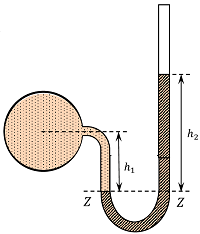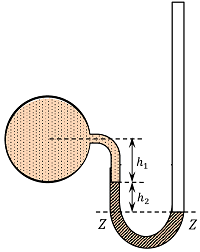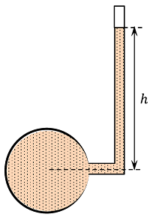What are Manometer & Piezometer?
Manometer and Piezometer are pressure measuring equipment made of glass tubes which are directly mounted in the pipeline through which a liquid flows.
- These devices are used for measure of pressure of liquid flowing in a pipeline.
- These arrangements directly give the reading of liquid pressure in terms of pressure head.
Difference between Manometer & Piezometer.
- A piezometer is a simple L-shaped glass tube. A manometer has U-shaped glass tube.
- A piezometer is a simple form of direct pressure measuring device. A manometer is an advanced form of piezometer.
- No other liquid is used in a piezoelectric glass tube. In manometer, normally mercury as a manometric liquid is used. For measurement of negative pressure (i.e., a pressure less than atmospheric pressure), a heavier liquid is used in U-Tube. For measurement of positive pressure (i.e., a pressure greater than atmospheric pressure), a lighter liquid can also be used in U-Tube.
- Larger limb of a piezometer is open to atmosphere. Hence, it can measure only positive pressures. Larger limb of a manometer can be open to atmosphere for measuring positive or negative pressures or can be connected to other section of same pipeline or other pipeline for comparing of pressure.
- A piezometer has limited use. A manometer has versatile use.
Piezometer
A piezometer is a simple L-shaped glass tube, which is directly mounted to the pipeline for measurement of positive pressure of the liquid flowing in the pipeline.
- A piezometer tube is consists of a narrow ( L ) shaped glass tube as shown in figure.
- End of the vertical limb of tube is open to atmosphere and the end of other limb is inserted and connected to the pipeline in which the liquid is flowing.
- Care is taken that, the piezometer tube is not projected inside the pipe internal surface. End of the tube should be smooth and flush with the inside surface of the pipe.
- No other gauge liquid is used in piezometer.

130401 PIEZOMETER TUBE
Due to pressure of the liquid in the pipeline, liquid rises in the vertical limb of piezometer. The height, to which the liquid rises up in the piezometer tube directly gives the reading ( h ) of pressure head of liquid flowing in the pipeline.
Use of a Piezometer
- A piezometer tube is used to measure moderate liquid pressures.
- A piezometer tube is suitable for measuring a gauge pressure because the surface of the liquid in the tube is exposed to the atmosphere.
- Since, tube is open to atmosphere, a piezometer tube is not suitable for measuring negative pressure as in such a case the air will enter in the pipe through the tube.
IMPORTANT – If pressure at a point is less than atmospheric pressure, then it is called negative pressure or vacuum.
If pressure at a point is more than atmospheric pressure, then it is called positive pressure.
Manometer
A manometer is an improved form of a piezometer tube to measure high liquid pressures and negative pressures.
Monometers are of following types –
- Simple manometer.
- Differential manometer.
- Inverted differential manometer.
- Micro manometer or sensitive manometer.
These devices will be discussed separately in detail –
Simple Manometer
A simple manometer is a slightly improved from of a piezometer tube.
A simple manometer is consists of a tube bent in U shape. One leg of U tube is attached to the gauge point of pipe line through which liquid is flowing whose pressure has to measure. The other end is open to the atmosphere as shown in figures (A) and (B).
- Generally, mercury is used in the bent of U tube as a gauge liquid.
- Mercury is ( 13.6 ) times heavier than water. Hence, a simple manometer is also suitable for measuring high pressures.
Working of a Simple Manometer
Consider that, a simple manometer connected to a pipe containing a light liquid under a high pressure. The high pressure in the pipe line will force the heavy liquid in the left limb of the U tube to move downward. This downward movement of the heavy liquid in the left limb will cause a corresponding rise of the heavy liquid in the right limb.
The common surface of contact of the heavy gauge liquid in U tube and light liquid in pipe line meet in the left limb, is known as datum line. Let, ZZ is the datum line as shown in figure.
Measuring of positive pressure
Consider about the arrangement of simple manometer as shown in figure to measure a positive pressure.
Let –
- ( h_1 ) is height in cm of the light liquid in the left limb above the datum line.
- ( h_2 ) is height in cm of the heavy manometer liquid in the right limb above the datum line.
- ( h ) is pressure head of liquid in the pipe line expressed in terms of head of water in cm.
- ( s_1 ) is specific gravity of the light liquid in pipe line.
- ( s ) is specific gravity of the heavy liquid in manometer U tube.
As the liquids in the U tube are in equilibrium, the pressures in the left limb and right limb above the datum line are equal.
Pressure in the left limb above the datum line is –
\left ( h + s_1 h_1 \right ) cm of water ……. (1)

Similarly, pressure in the right limb above the datum line is –
\left ( s h_2 \right ) cm of water …….. (2)
For equilibrium, equations (1) and (2) must be equal.
Therefore, \quad ( h + s_1 h_1 ) = ( s h_2 )
Thus, pressure head of liquid in the pipe line is –
h = \left ( s h_2 - s_1 h_1 \right ) cm of water column.
Measuring of negative pressure
Now, consider about the arrangement of simple manometer as shown in figure to measure a negative pressure.
In this case the negative pressure in pipe will suck the light liquid which will pull-up the heavy liquid in the left limb of the U tube. This upward movement of the heavy liquid in the left limb will cause a corresponding fall of the liquid in the right limb.

Let, line ZZ is the datum line corresponding to the top level of the heavy liquid in the right column.
- ( h_1 ) is height in cm of the light liquid in the left limb above the datum line.
- ( h_2 ) is height in cm of the heavy manometer liquid in the left limb above the datum line.
- ( h ) is pressure head of liquid in the pipe line expressed in terms of head of water in cm.
- ( s_1 ) is specific gravity of the light liquid in pipe line.
- ( s ) is specific gravity of the heavy liquid in manometer U tube.
Pressure in the left limb above the datum line is –
\left ( h + s_1 h_1 + s h_2 \right ) cm of water.
Pressure in the right limb = 0
For equilibrium condition equating these two pressures –
( h + s_1 h_1 + s h_2 ) = 0
Or, \quad h = - \left ( s_1 h_1 + s h_2 \right ) cm of water.
Use of Simple Manometer
- A simple manometer is used for measuring high pressure of a lighter liquid ( i.e. a liquid of low specific gravity ) flowing through a pipe line.
- It is also used to measure negative pressures.

